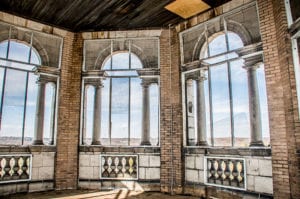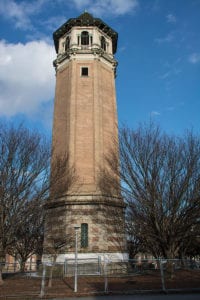Roland Water Tower Preservation Campaign
Roland Water Tower After Proposed Restoration, with
“Pocket Park” Around Base.
Let’s make 2013 the year the tower gets saved.
Preservationists have secured a quarter-million-dollar state bond, a matching grant that must be matched dollar for dollar by the community and other fund-raising efforts. The total cost of restoring the tower, developing a historical display room within it, and creating a park around it will be some $1.2 million.
Won’t you help save one of Baltimore’s most remarkable buildings? Yes, you say? That’s wonderful — in which case, please donate here or pledge here.
2012 Water Tower Fact Sheet (click link).
Background
The Roland Water Tower is under threat of demolition by Baltimore City but the neighborhood has stepped up to raise funds to restore the historic tower and create a community park on the .75 acres at the base. The Roland Water Tower — located at 4210 Roland Avenue, at the intersection of the Roland Park, Hoes Heights, Hampden and Rolden communities — is one of only two Beaux Arts water towers remaining in the Maryland. It a historic landmark for the community and, once restored, it will be a wonderful gathering space for locals.
Located in Roland Park’s smallest plat, Plat 4, the Roland Water Tower is one of the Roland Park area’s most well known historic structures. It is situated on one of Baltimore City’s highest points and commands a breathtaking view of the surrounding area. The tower was originally built in 1904-1905 to provide water for the adjacent areas, but fell into disuse when Baltimore City in 1930 moved to using reservoirs exclusively for its water supply. In 1974, the tower was listed on the National Register of Historic Places and, in 2008, the city designated the tower a City Landmark Building. In recent years, however, the tower has deteriorated severely — to such an extent that it was fenced off in July 2009 to prevent passersby getting too close to it, and thus potentially being hit by falling debris.
The tower is one of only two such water towers in Baltimore, the other being the slightly larger West Arlington Water Tower. West Arlington is about two miles northwest of Druid Hill Park, sandwiched between Liberty Road to the south and Reisterstown Road to the north. The West Arlington tower, pictured at left (click thumbnails), is in a similar state of disrepair. For readers interested in seeing it, it is located at the northeast corner of the intersection of Oakford and Granada avenues.
The important take-home is that, once the Roland and West Arlington towers collapse, there will be no Beaux Arts water towers left on Maryland — not a single one. This tower is worth saving.
In summer 2009, a new preservation group was formed with a view to securing the rehabilitation of the Roland tower, the “Friends of the Roland Water Tower” (FRWT). On July 2, 2009, the Roland Park Civic League voted to support the efforts of the FRWT. If you would like to get involved in the preservation effort, please contact the FRWT at e-mail address RolandH2OTower@yahoo.com, or visit the group’s Facebook page at http://www.causes.com/rolandh2otower.
Likewise in 2012, the Roland Park Community Foundation adopted the tower and its preservation as part of the foundation’s Open Space Campaign. In October 2012, the long-awaited environmental cleanup of the tower began, funded by the community foundation. A local company, Padeens, Inc. cleared out 300 bags of animal, mostly bird, excrement. In addition, the interior was screened and sealed so no more animals can enter.
The Tower Project
The goals of the community foundation’s project are:
Historic Preservation: Fully restore and preserve the tower.
Open Space: Landscape the exterior grounds and create a three-quarter-acre “pocket park” at the foot of the tower for use by all of the surrounding communities. Senior housing and schools are nearby, and there is no other park in the immediate vicinity.
Educational Programming and Museum Space: Restore interior space for museum and office use. Museum displays will include the history of the Hoes Heights neighborhood, exhibits on the history of surrounding neighborhoods, the water tower’s origins and related background on Baltimore’s early water supply system. This part of the project will be easier said that done, as the vast majority of the interior of the tower is taken up by the still-extant “stand pipe” (i.e., the water tank).
Observation Space: A renovated viewing area at the top of the tower would allow public access to spectacular, panoramic views of Baltimore. In keeping with Americans with Disability Act guidelines, photographs of the panoramic views will be displayed on the handicap-accessible first floor for disabled visitors.
Community Space: A redesigned and restored interior would provide a gathering place for community events and support space for outdoor festivals.
About the Tower
The octagonal masonry tower is 148 feet tall, made from brick and terra cotta, with a tripartite vertical organization consisting of a heavy block base, capped with bright green Spanish roof tiles. Its well-proportioned Italianate structure was designed by the city water company’s architect, William Fizone. Its construction is attributed to John Stack and Sons, a builder responsible for constructing many of Baltimore City’s Victorian-era buildings.
The surrounding neighborhoods contribute to the tower’s historic significance. They include Hampden, a former mill town; Hoes Heights, a tight-knit neighborhood in part featuring row homes built by and for African-American servicemen returning from World War II; Roland Park, a turn-of-the-century community designed by notable planners Frederick Law Olmsted, Jr. and George Kessler; and Rolden, with a variety of residential buildings dating from the early 20th century.
Currently, the Tower is a public safety and public health hazard. In 2009, the city determined that the exterior deterioration of the upper portion of the Tower was serious, even dangerous to the public, and enclosed the tower and its environs with a tall chain-link fence. A 2011 structural engineering analysis, funded by Preservation Maryland Heritage Fund and the Roland Park Community Foundation, determined that the foundation and structural components of the tower are sound, but that the roof, parapet elements and upper floor require stabilization to prevent further deterioration. Stabilization and restoration of the terracotta roof upper portion of the building is immediately required to prevent large portions of the exterior structure from falling and causing greater damage. The ugly, fenced-in condition of the site depresses the vitality of the surrounding neighborhoods and negatively affects quality of community life and property values.
Community Support
There is strong community support for stabilization and restoration of the tower, along with the creation of a surrounding park. This was a stated goal of the 2009-2010 Greater Roland Park Master Plan that includes the communities of Roland Park, Hoes Heights, Rolden, Wyndhurst, Keswick, Evergreen, and Cross Keys. Concerned residents have also joined together to form the Friends of the Roland Water Tower, an advocacy group that has organized community events at the Tower. The Hoes Heights community, an early African-American neighborhood (the land was owned pre-Civil War by a manumissioned slave named Grandison Hoe), has expressed a wish to display its rich history within the renovated interior space at the base of the tower.
Elisabeth Sachs, Allison Barlow,
Matthew Fitzsimmons and Doug Munro
Sep. 7, 2009 and Dec. 31, 2012
The opinions expressed in the above writing and throughout this web page are those of the authors and do not necessarily reflect the views or stated policy positions of the Roland Park civic associations.
Friends of Roland Water Tower: Mission Statement
Our Beliefs
In consideration of the facts that:
- The 105-year-old Roland Water Tower is a building of historical value;
- The Roland Water Tower is a civic monument of architectural beauty, exemplifying the design principles of the City Beautiful Movement;
- The Roland Water Tower is a gateway landmark anchoring the communities of Cross Keys, Evergreen, Hampden, Hoes Heights, Keswick, Medfield, Roland Park, and Wyndhurst;
- The Roland Water Tower, in its location on one of Baltimore’s highest points, offers sweeping views of a beautiful cityscape from its summit;
and - The Roland Water Tower resides on a valuable tract of city green space that is currently compromised by a chain-link fence.
Members of the surrounding communities have banded together to form the Friends of the Roland Water Tower.
Our Mission
The Friends of the Roland Water Tower is an organization committed to restoring the Tower to a state of engineering stability and aesthetic beauty, as well as exploring strategies to foster stewardship for the tower and surrounding green space for future generations.
— FRWT, Summer 2009









